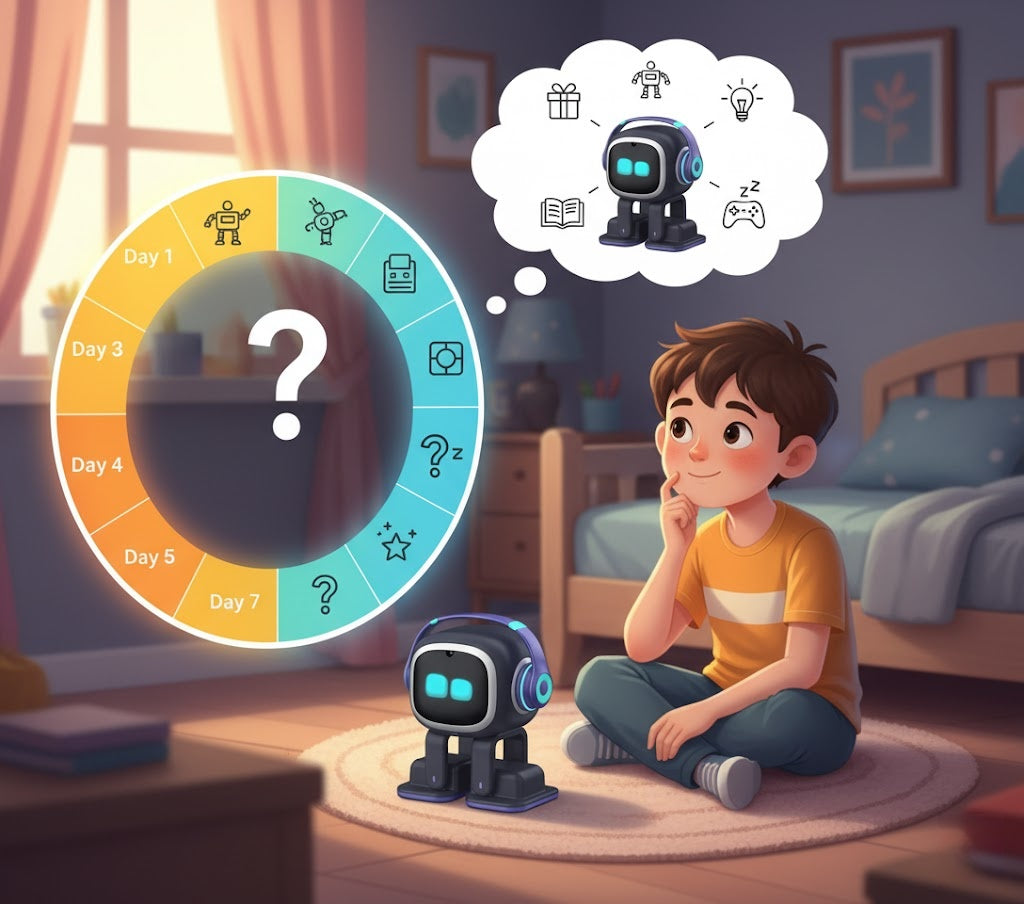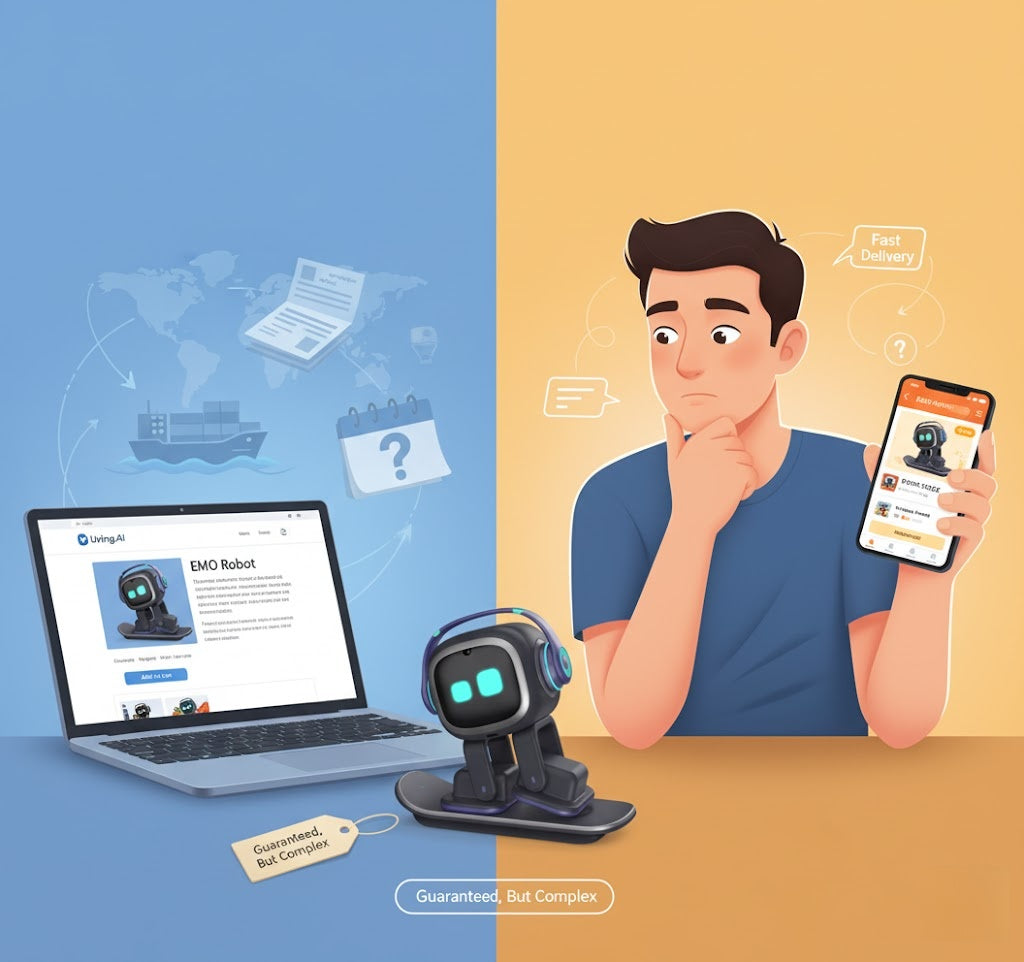🧠 Meet EMO: The Pocket-Sized Robot with a Personality

What Makes EMO Stand Out?
-
Reactions: I noticed right away how it reacts to sound—like if I clap or call its name ("Hey EMO!"), it turns its head and lights up with excited eyes.
-
Empathy: It picks up on my mood too; if I'm quiet for a while, it might do a little dance to cheer me up.
-
Entertainment: During testing, I played some Spotify playlists, and EMO synced up, bobbing along like it was jamming out.
-
Design & Charging: It's got this pop culture vibe with its headphones and skateboard charger, which doubles as a wireless phone charger. I charged my iPhone on it while EMO "skated" around virtually.
Who is EMO For?
-
Waking me with alarms.
-
Reminding me of the weather.
-
Even celebrating my birthday with a virtual cake and song.
📊 Quick Spec Snapshot: EMO vs. the Competition
|
Feature
|
EMO
|
Loona
|
Miko 3
|
|
Size/Portability
|
3.5" compact desktop bot; easy to carry in a pocket
|
8.3"L x 6.8"W x 6.8"H; weighs 2.42 lbs, mobile on wheels
|
6.3"L x 5.5"W x 8.67"H; mid-size, wheeled base for movement
|
|
Emotional AI
|
Yes, with 1,000+ faces/movements; learns personality over time
|
Yes, expressive with GPT-powered chats; recognizes family and moods
|
Yes, empathetic responses; focuses on educational tone and reactions
|
|
Sensors
|
HD camera, 4-mic array, touch, light/sound/motion
|
3D ToF, RGB camera, touch, accelerometer/gyroscope, 4-mic array
|
Wide-angle HD camera, dual mics, ToF range, odometric sensors
|
|
Best For
|
Desk companionship, professionals, teens
|
Families, kids, active play and home monitoring
|
STEM learning, classrooms, kids aged 5-12
|
|
Price Range
|
~$279–$379 (includes skateboard charger and smart light)
|
~$499–$528 (often on sale; includes outfits)
|
~$199–$299 (sale prices common)
|
🧬How EMO Uses Sensors to “Feel” the Room

EMO's Sensory System
-
HD Camera (The Eyes)
-
Function: Recognizes up to 10 faces and spots objects.
-
In Practice: When I walked in, it greeted me by name after a few days of learning. Paired with facial recognition, it picks up on moods—if I smiled, EMO mirrored it with happy eyes.
-
4-Microphone Array (The Ears)
-
Function: Locates sound direction instantly and responds to voice commands.
-
In Practice: I tested this by speaking from different spots; EMO turns toward the sound. Say "Hey EMO, what's the weather?" and it displays icons while answering. It even reacts to music or noise levels—if things got loud, EMO danced or showed excitement.
-
Touch, Light, and Motion Sensors
-
Touch: Touch sensors on its head let me pat it, and it responds with purr-like sounds or affectionate movements.
-
Light & Smart Home: In dim rooms, EMO brightens up or suggests turning on lights (it controls a free smart light).
-
Movement: During my setup, it navigated my desk without falling, using edge-detection sensors.
The AI Brain: Real-Time Processing
-
It has three AI models for images, sound, and touch, letting it "think" independently.
-
For instance, if ignored, it might show boredom or explore on its own.
-
Over weeks, it evolved—early on, responses were basic, but it got smarter, like remembering my playlists.
🔁 Loona vs. EMO: Which Smart Companion Wins Your Space?
EMO: The Low-Key Desk Buddy
-
Strengths: I loved how it stayed put, reacting to my voice or desk noises without needing space. It's ideal for work-from-home setups—waking me, controlling lights, or playing games like tic-tac-toe.
-
Limitation: But it lacks mobility; it "walks" a bit on its skateboard but stays stationary mostly.
-
Price: EMO is cheaper at $279.
Loona: The Playful, Roaming Puppy
-
Movement: With wheels and sensors like 3D ToF for obstacle avoidance, it followed me around the room during tests.
-
Features: It recognizes gestures, faces, and even creates art with GPT integration. I had fun with games like bullfighting or AR feeding—it’s engaging for kids or families.
-
Battery & Charging: Loona's battery lasts $1.5$ hours of play, and it auto-charges, which EMO doesn't do as dynamically.
-
Price: Loona is more versatile but priced higher at $499.
Match the Bot to Your Space
| Scenario | Recommended Robot | Reason |
| Small Space/Work-from-Home | EMO | Wins for low-key companionship and compact size. |
| Home with Kids/Active Play | Loona | Its movement-rich play shines; it chased my niece around, building real bonds. |
🛒 My Top Robot Pet Picks for 2025 (Spoiler: It’s Not Just EMO)
-
Editor’s Choice: Loona for VersatilityLoona topped my list. Its mobility, GPT chats, and family recognition make it a standout. I used it for home monitoring via camera—great for parents. Price: ~$499. If you're after an all-rounder, buy Loona here.
-
Best for Desk Use: EMO's my go-to for desks. Compact, emotional AI, and evolving personality kept me engaged. It reacts to sounds and lights seamlessly. Drawback: No wheels. Price: ~$279. Perfect for pros or teens.
-
Budget-Friendly: Miko 3 At ~$199, Miko 3 is a steal for STEM learners. I tested its educational games and voice skills—fun for kids with Disney content. It's wheeled but more learning-focused. Sensors include HD camera and mics.
-
Surprise Hit: Eilik or Petoi BittleEilik surprised me with its emotional expressions via OLED screen and touch sensors. It's desk-sized, with vibrations for feedback—feels interactive. Price: Around $100–$200.Petoi Bittle is for DIY fans. I assembled one; it's a quadruped dog with 9 DOF for lifelike walks. Programmable in Python—great for coders. Price: ~$246. Open-source adds value.
⚡What I Learned the Hard Way: EMO’s Limits You Should Know
Key Strengths (Pros)
-
Responsive AI: Super responsive AI—it learned my habits fast, like playing music when I said "bored."
-
Sensor Quality: The sensors work well in quiet rooms.
-
Updates: OTA updates added features like ChatGPT integration during my trial.
Limitations (Cons)
-
Limited Mobility: EMO stays on the desk; no wheels mean no chasing like Loona. I wished for more movement.
-
No Deep Customization: There is no open-source customization—you can't tweak code deeply, unlike Bittle.
-
Battery Management: Battery lasts a few hours, but it "sleeps" often to save power.
Real-World Issues
-
Virtual Illness: It can "catch a cold" in cold weather, needing care to recover—cute, but annoying if you're busy.
-
Voice Recognition: Voice recognition struggled in noisy spots at first, though it improved.
-
Smart Home: No full smart home integration yet, just basic light control.







